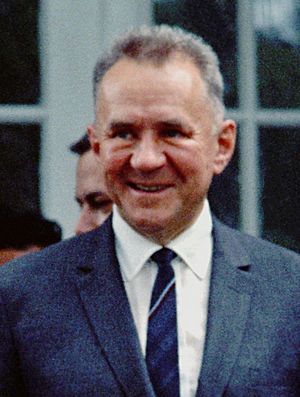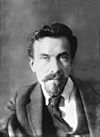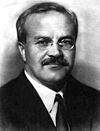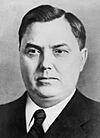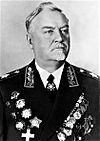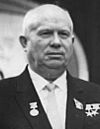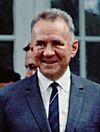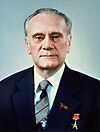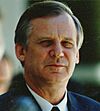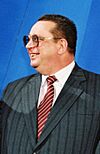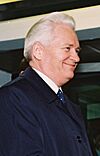Premier of the Soviet Union facts for kids
Quick facts for kids Premier of the Soviet Union |
|
|---|---|

|
|
| Style | Mr. Premier (informal) His Excellency (diplomatic) |
| Reports to | Supreme Soviet |
| Residence | Kremlin Senate, Moscow |
| Appointer | Supreme Soviet |
| Formation | 6 July 1923 |
| First holder | Vladimir Lenin |
| Final holder | Ivan Silayev |
| Abolished | 26 December 1991 |
| Succession | Prime Minister of Russia |
| Deputy | First Deputy Premier Deputy Premier |
The Premier of the Soviet Union (Russian: Глава Правительства СССР) was the head of government of the Union of Soviet Socialist Republics (USSR). Twelve individuals held the post. Among the most known are Vladimir Lenin and Joseph Stalin.
Contents
Names
The office had four different names throughout its existence: Chairman of the Council of People's Commissars (1923–1946), Chairman of the Council of Ministers (1946–1991), Prime Minister (January – August 1991) and Chairman of the Committee on the Operational Management of the Soviet Economy (August–December 1991). Long before 1991, most non-Soviet sources referred to the post as "Premier" or "Prime Minister."
History
Lenin's First Government was created on 6 July 1923 by the Central Executive Committee with Lenin as its first chairman. The government was empowered to initiate decrees and legislation that were binding throughout the USSR. The longest serving premier in the history of the USSR was Alexei Kosygin, who was appointed head of government after the ousting of Nikita Khrushchev in 1964. However, Kosygin's prestige was weakened when he proposed the economic reform of 1965. In 1991, upon Valentin Pavlov's ascension to the premiership, the Council of Ministers was abolished and replaced with the Cabinet of Ministers. After the August coup of 1991, the majority of the cabinet members endorsed the coup, leading to the Cabinet of Ministers dissolving and being replaced by the Committee on the Operational Management of the Soviet Economy. The government of the Russian Soviet Federative Socialist Republic began seizing Soviet ministries in the aftermath of the coup, and by December 1991 the Soviet government had completely lost control of itself and shut down entirely.
Under the 1977 Soviet Constitution, the head of government was the leader of the highest executive and administrative organ of state. The head of government was appointed by and accountable to the Supreme Soviet (and its Presidium). The head of government was tasked with resolving all state administrative duties within the jurisdiction of the USSR to the degree which were not the responsibility of the Supreme Soviet or its Presidium. The head of government managed the national economy, formulated the five-year plans and ensured socio-cultural development. It functioned as the most influential office of government until the establishment of the Office of the President of the Soviet Union in 1990.
Vladimir Lenin and Joseph Stalin died in office of natural causes, and three premiers resigned—Alexei Kosygin, Nikolai Tikhonov and Ivan Silayev. Another three were concurrently party leader and head of government (Lenin, Stalin and Nikita Khrushchev). The one who spent the shortest time in office was Ivan Silayev, at 119 days. Kosygin spent the longest time in office—16 years.
List of officeholders
| No. | Portrait | Name (Birth–death) |
Term | Electorate | Cabinets | Ref. | ||
|---|---|---|---|---|---|---|---|---|
| Took office | Left office | Duration | ||||||
| 1 | Vladimir Lenin (1870–1924) |
6 July 1923 | 21 January 1924 † | 228 days | – | Lenin I–II | ||
| 2 | Alexei Rykov (1881–1938) |
2 February 1924 | 19 December 1930 | 6 years, 320 days | 1924 1925 1927 1929 |
Rykov I–II–III–IV–V | ||
| 3 | Vyacheslav Molotov (1890–1986) |
19 December 1930 | 6 May 1941 | 10 years, 138 days | 1931 1935 1936 1937 |
Molotov I–II–III–IV | ||
| 4 | Joseph Stalin (1878–1953) |
6 May 1941 | 5 March 1953 † | 11 years, 303 days | 1946 1950 |
Stalin I–II–III | ||
| 5 | Georgy Malenkov (1902–1988) |
6 March 1953 | 8 February 1955 | 1 year, 339 days | 1954 | Malenkov I–II | ||
| 6 | Nikolai Bulganin (1895–1975) |
8 February 1955 | 27 March 1958 | 3 years, 47 days | 1958 | Bulganin | ||
| 7 | Nikita Khrushchev (1894–1971) |
27 March 1958 | 15 October 1964 | 6 years, 202 days | 1962 | Khrushchev I–II | ||
| 8 | Alexei Kosygin (1904–1980) |
15 October 1964 | 23 October 1980 | 16 years, 8 days | 1966 1970 1974 1979 |
Kosygin I–II–III–IV–V | ||
| 9 | Nikolai Tikhonov (1905–1997) |
23 October 1980 | 27 September 1985 | 4 years, 339 days | 1984 | Tikhonov I–II | ||
| 10 | Nikolai Ryzhkov (1929–2024) |
27 September 1985 | 14 January 1991 | 5 years, 109 days | 1989 | Ryzhkov I–II | ||
| 11 | Valentin Pavlov (1937–2003) |
14 January 1991 | 28 August 1991 | 226 days | – | Pavlov | ||
| 12 | Ivan Silayev (1930–2023) |
28 August 1991 | 25 December 1991 | 119 days | – | Silayev | ||
See also
 In Spanish: Presidente del Consejo de Ministros de la Unión Soviética para niños
In Spanish: Presidente del Consejo de Ministros de la Unión Soviética para niños
- Bibliography of the Russian Revolution and Civil War § Government
- Bibliography of Stalinism and the Soviet Union § Government
- Bibliography of the Post Stalinist Soviet Union § Government
- Deputy Premier of the Soviet Union
- First Deputy Premier of the Soviet Union
- List of heads of state of the Soviet Union
- List of leaders of the Soviet Union


